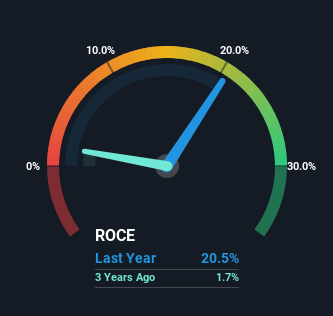Teradata (NYSE:TDC) Could Become A Multi-Bagger
Did you know there are some financial metrics that can provide clues of a potential multi-bagger? One common approach is to try and find a company with returns on capital employed (ROCE) that are increasing, in conjunction with a growing amount of capital employed. Put simply, these types of businesses are compounding machines, meaning they are continually reinvesting their earnings at ever-higher rates of return. With that in mind, the ROCE of Teradata (NYSE:TDC) looks great, so lets see what the trend can tell us.
What Is Return On Capital Employed (ROCE)?
For those that aren't sure what ROCE is, it measures the amount of pre-tax profits a company can generate from the capital employed in its business. The formula for this calculation on Teradata is:
Return on Capital Employed = Earnings Before Interest and Tax (EBIT) ÷ (Total Assets - Current Liabilities)
0.21 = US$180m ÷ (US$1.9b - US$996m) (Based on the trailing twelve months to December 2023).
Thus, Teradata has an ROCE of 21%. That's a fantastic return and not only that, it outpaces the average of 7.3% earned by companies in a similar industry.
See our latest analysis for Teradata
In the above chart we have measured Teradata's prior ROCE against its prior performance, but the future is arguably more important. If you'd like, you can check out the forecasts from the analysts covering Teradata for free.
So How Is Teradata's ROCE Trending?
You'd find it hard not to be impressed with the ROCE trend at Teradata. The data shows that returns on capital have increased by 327% over the trailing five years. The company is now earning US$0.2 per dollar of capital employed. Speaking of capital employed, the company is actually utilizing 35% less than it was five years ago, which can be indicative of a business that's improving its efficiency. Teradata may be selling some assets so it's worth investigating if the business has plans for future investments to increase returns further still.
On a side note, we noticed that the improvement in ROCE appears to be partly fueled by an increase in current liabilities. Essentially the business now has suppliers or short-term creditors funding about 53% of its operations, which isn't ideal. Given it's pretty high ratio, we'd remind investors that having current liabilities at those levels can bring about some risks in certain businesses.
The Key Takeaway
From what we've seen above, Teradata has managed to increase it's returns on capital all the while reducing it's capital base. Astute investors may have an opportunity here because the stock has declined 20% in the last five years. That being the case, research into the company's current valuation metrics and future prospects seems fitting.
If you'd like to know about the risks facing Teradata, we've discovered 1 warning sign that you should be aware of.
Teradata is not the only stock earning high returns. If you'd like to see more, check out our free list of companies earning high returns on equity with solid fundamentals.
Have feedback on this article? Concerned about the content? Get in touch with us directly. Alternatively, email editorial-team (at) simplywallst.com.
This article by Simply Wall St is general in nature. We provide commentary based on historical data and analyst forecasts only using an unbiased methodology and our articles are not intended to be financial advice. It does not constitute a recommendation to buy or sell any stock, and does not take account of your objectives, or your financial situation. We aim to bring you long-term focused analysis driven by fundamental data. Note that our analysis may not factor in the latest price-sensitive company announcements or qualitative material. Simply Wall St has no position in any stocks mentioned.

 Yahoo Finance
Yahoo Finance 
